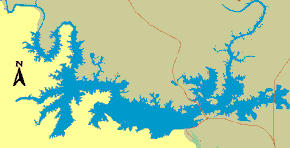Fishing
- Possession and Transport of Exotic Aquatic Species
- Licenses & Regulations
- ShareLunkers
- Fish Identification
- Fish Consumption
- Texas Freshwater Fisheries Center
Water Resources
- Texas Reservoir Levels
- US Army Corps of Engineers
- Texas Water Issues
- Golden Alga
- Aquatic Vegetation
12861 Galm Road #7
San Antonio, Texas 78254
(210) 688-9460 or 688-9516
Mitch Nisbet, Biologist
Local Information
- National Park Service
HCR #3, Box 5J
Del Rio, Texas 78840
(830) 775-7491
amis_interpretation@nps.gov
Nearby State Parks:
Amistad Reservoir
Quick Links: Fishing Regulations | Angling Opportunities | Cover & Structure | Tips & Tactics
BOATER ADVISORY: Zebra and Quagga mussels have invaded this reservoir! CLEAN, DRAIN AND DRY your boat, trailer, livewells/bait buckets, and other gear before traveling to another water body. Draining water is required by law and possession and transport of invasive mussels is illegal.
Lake Characteristics
Location: On the Rio Grande, 12
miles northwest of Del Rio in Val Verde County
Surface area: 64,900 acres
Maximum depth: 217 feet
Impounded: 1969
Water Conditions
Current
Lake Level
Conservation Pool Elevation: 1117 ft. msl
Fluctuation: Depends on
rainfall and downstream irrigation demands. Annual fluctuations
can be 5-10 feet. Historical fluctuations have dropped lake
as much as 50 feet below conservation pool.
Normal Clarity: Clear to slightly stained
Reservoir Controlling Authority
International Boundary & Water
Commission
1-800-262-8857
Aquatic Vegetation
Coverage is dependent on water level. In 1999, a survey indicated approximately 1,000 acres of aquatic vegetation, primarily hydrilla.
Predominant Fish Species
Lake Records
Current
Fishing Report
Stocking History
Latest Survey Report
Lake Maps
A free map of the Amistad National Recreation Area is available from the National Park Service's Amistad Visitor Information Center.
Fishing Regulations
On the Texas side of the lake, all species are managed under current statewide regulations. For recreational anglers fishing Mexican waters, a Mexico fishing license is required for everyone in the boat. Mexico boat permits are no longer required. For information on Mexico's fishing regulations, visit the National Aquaculture and Fishing Commission (CONAPESCA) website.
Mexico licenses can be purchased in Del Rio at Amistad Marine (Highway 90 West, 830/775-0878) or Fisherman's Headquarters (Chevron at the intersection of 90 & 277 N, 830/774-5670.
Angling Opportunities
Largemouth bass are the most popular and most abundant sportfish in the reservoir. Channel and blue catfish are present in good numbers with an occasional flathead showing up. Striped bass are popular and sought by anglers due to their strong fighting characteristics and their potential for trophy sizes. Frequent stockings by the Texas Parks and Wildlife Department maintain the striper population because they have not successfully reproduced in this reservoir. White bass provide popular seasonal fishing during spring spawning runs. Smallmouth bass are present; anglers report better success with this species in the Devils River arm of the lake.
| Species | Poor | Fair | Good | Excellent |
|---|---|---|---|---|
| Largemouth Bass | ||||
| Smallmouth Bass | ||||
| Channel & Blue Catfish | ||||
| White & Striped Bass |
Fishing Cover/Structure
Amistad Reservoir is dominated by rocky structure. The lake abounds in rock ledges, steep rocky drop offs and rocky points and shorelines. Additional structure is provided by isolated flooded timber, and TPWD has worked with local organizations to place a Christmas-tree fish habitat near the Governor's Landing camping area. Periodically, flooded terrestrial vegetation (brush) provides important fish habitat following water level increases.
Use the Habitat Structure Viewer for an interactive map of fish habitat structures and downloadable GPS coordinates.
Tips & Tactics
Largemouth bass anglers are most successful during the fall, winter, and spring months. Topwater baits, buzzbaits and spinner baits work well in the early morning and late evening. Crankbaits can be effective along rocky shorelines, points and dropoffs. At midday many anglers turn to plastics such as Texas and Carolina rigged worms or grubs to effectively fish the deeper waters near vegetation or rocky structure. Catfish anglers can find channel and blue catfish throughout the lake. Stinkbait and cutbait work well for both species. Many anglers try to improve catch rates by "baiting" catfish holes with sour grain to attract the catfish. The best action for white bass is during the spring spawning runs. These occur from late January through March as whites migrate up rivers to spawn. Effective baits include rattle traps, jigging spoons and live bait such as minnows.
